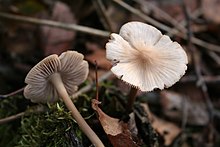Mycenaceae
| Mycenaceae Temporal range:
| |
|---|---|

| |
| Mycena galericulata | |
| Scientific classification | |
| Domain: | Eukaryota |
| Kingdom: | Fungi |
| Division: | Basidiomycota |
| Class: | Agaricomycetes |
| Order: | Agaricales |
| Family: | Mycenaceae Overeem (1926) |
| Type genus | |
| Mycena (
Pers.) Roussel (1806) | |
| Genera | |
The Mycenaceae are a
saprobic, have a cosmopolitan distribution, and are found in almost all ecological zones.[2] The family was circumscribed by Caspar van Overeem
in 1926.
The extinct genus Protomycena, described from Burdigalian age Dominican amber found on the island of Hispaniola[3] is one of four known agaric genera in the fossil record.[4]
Phylogeny
| |||||||||||||||||||||||||||||||||||||||||||||||||||||||||||||||||||||||||||
| Phylogeny of the Mycenaceae based on nuclear large ribosomal subunit gene sequences.[5] |
A large-scale
phylogenetic analysis study of the Agaricales published by a consortium of mycologists in 2002 adopted the name Mycenaceae for a strongly supported clade consisting of Dictyopanus, Favolaschia, Mycena, Mycenoporella, Prunulus, Panellus, Poromycena, and Resinomycena.[5] Dictyopanus has since been wrapped into Panellus,[6] and both Poromycena[7] and Prunulus into Mycena.[8]
See also
Wikimedia Commons has media related to Mycenaceae.
References
Cited text
- Kirk PM, Cannon PF, Minter DW, Stalpers JA (2008). Dictionary of the Fungi (10th ed.). Wallingford, UK: CAB International. p. 446. ISBN 978-0-85199-826-8.
